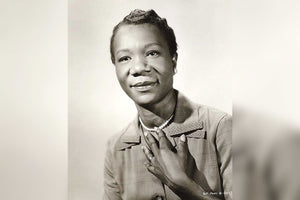Birthday: August 26, 1921
Who was Naomi Parker?
Naomi Parker was an American war worker during World War II. She was best known for being the model for the iconic “We Can Do It!” WWII poster and was known to most as Rosie the Riveter.
Facts About Naomi Parker
- She was working in the Alameda Naval Air Station when a photographer snapped the
- photo which will become the inspiration for Rosie the Riveter.
- She was born in Tulsa, Oklahoma but her family moved soon after her birth.
- She was only 20 years old when the picture was taken.
- She was the third child of Joseph Parker, a mining engineer, and his wife, Ester Leis.
- She had several siblings but was especially close to her sister Ada.
Naomi Parker’s Biography
Early Life
She was born as Naomi Fran Parker on August 26, 1921, in Tulsa, Oklahoma to parents Joseph Parker and Esther Leis. She was the third child in a family of eight and her father’s work as a mining engineer took him and his family all around the US, moving to another state soon after her birth in Oklahoma.
Because of the nature of her father’s job, Naomi and her siblings grew up mostly in California where she and the rest of her family were residing when the attack on Pearl Harbor happened.
Husband and Children
Naomi Parker was married three times, being divorced once and widowed twice. She first married Joseph Blankenship, a marriage that ended in divorce.
After which she married John Muhlig that ended when he died in 1971. She then married Charles Fraley in 1979 and remained married to him until he died in 1998.
She had one son with her first husband whose name is also Joseph as well as six stepchildren with her third husband, Charles Fraley.
Turning Point
Before becoming known as the woman that inspired the iconic Rosie the Riveter “We Can Do It!” poster, she and her sister Ada were working at the Naval Air Station in Alameda, California. She unwittingly became one of the poster children of the wartime effort when a photographer from the Acme agency snapped the photo that will serve as the inspiration for the iconic wartime poster.
At the time, she was only 20 years old and was assigned to the station’s machine shop, repairing airplane wings.
Mission and Work
After the attack on Pearl Harbor, she and her sister Ada, like thousands of other women at the time, went to work to support the war effort. She and her sister were assigned to the Alameda Naval Air Station where they worked in the machine shop for assembling aircraft. Around 1942, a photographer snapped a photo of her operating a machine which was then published in the local press in the same year. The following year, the iconic “We Can Do It!” poster by J. Howard Miller was published as part of a series of images that were put up in
factories. The iconic poster was used exclusively in the Westinghouse Electric Corporation Plants that were heavily involved in supporting the wartime effort.
The posters served to boost the morale of factory workers aiding the war effort and many assumed that the artist received his inspiration from the photo published in the local press.
After the war, she and her sister traded the machines for aprons, working as waitresses in the Palm Springs restaurant, The Doll House. This restaurant was popular amongst Hollywood celebrities at the time. The poster remained in relative obscurity until its rediscovery in the 1980s and its subsequent use as a representation of female strength and as a symbol of the feminist movement.
However, the image on the poster was known as Rosie the Riveter and for many years, it was thought that another woman, Geraldine Hoff Doyle, was the inspiration for the poster. It wasn’t until a professor named James J. Kimble from Seton Hall University became interested that the misunderstanding was cleared up.
He managed to track down the original photo and found it was credited to young Naomi Parker. He informed the now elderly Naomi Parker of the discovery and found out that she knew about the misidentification and their attempts to correct it have been rebuffed.
Death and Legacy
Naomi Parker lived a good life before passing peacefully in Longview, Washington at the age of 96 on January 20, 2018. Her legacy as the inspiration for the iconic Rosie the Riveter will never be forgotten. Not only did it represent the role of women in supporting the wartime effort, but it also served as a symbol of female strength as well as of the feminist movement.
![]() Fast Shipping
Fast Shipping![]() Subscribe to our Newsletter
Subscribe to our Newsletter![]() 🌟 New Global Competition 🌟
🌟 New Global Competition 🌟















